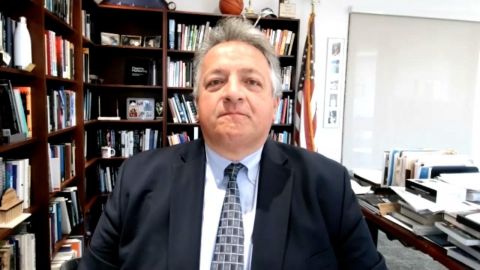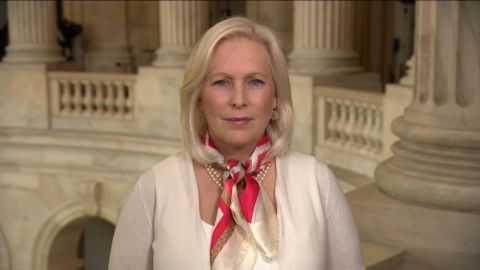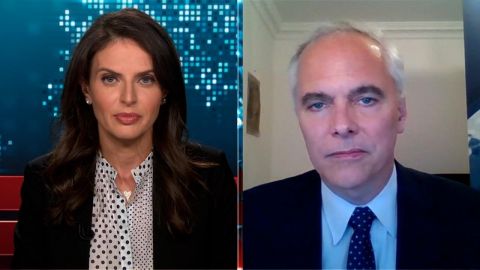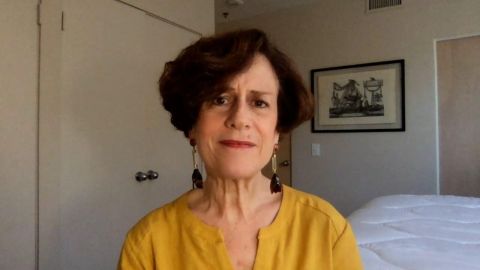Read Transcript EXPAND
BIANNA GOLODRYGA: And now, as global vaccination rates continue to tick up, some are starting to imagine life after the pandemic. But we can’t move forward
without looking back says our next guest, Moderna chairman, Noubar Afeyan. He has coauthored a report as the CEO of Flagship Pioneering along with the
Eurasia group on lessons learned from the COVID crisis and how to build a better future. Here he is with Walter Isaacson.
(BEGIN VIDEO CLIP)
WALTER ISAACSON: Thank you, Bianna. And Dr. Noubar Afeyan, welcome back to the show.
NOUBAR AFEYAN, CO-FOUNDER AND CHAIRMAN, MODERNA: Great to be here, Walter.
ISAACSON: You have this big report that’s just come out with the Eurasian group and you and others and it talked about preemptive medicine. What does
that mean other than getting vaccines ready?
AFEYAN: Well, Walter, if medicine as a field, which has brought, you know, tremendous value to humanity, has increasingly focused on the state after a
disease has been diagnosed. And so, all of our brightest minds are working on the progression of disease, late stage disease, what to do to save
lives. And that’s all fine. But as in parallel we’ve been learning about the biology underlying what leads to disease, what we realize is that the
later you wait the harder it is to treat.
And in fact, we’re increasingly finding that there are conditions broadly that we call prediseases that are pathways to a disease where we could
think about intervening at that point. So, the whole idea of preemptive medicine is if medicine decided to consider its mandate not just finding
and treating disease but to actually find and intervene with predisease and altogether prevent disease if it is at all possible. And I think our
general assumption is that is not possible, but I would argue that it’s not possible because it has not been what we’ve been focused on so far.
And I think, ultimately, there will be many diseases that can be delayed so much that you might as well have prevented them in one’s lifetime.
ISAACSON: Does that mean using artificial intelligence to try to predict what diseases might come next?
AFEYAN: Artificial intelligence is part of the arsenal we now have available that only a few years ago would not have been as readily
available. Identifying markers for predisease states, the more we learn about how cells are malfunctioning, the more we can think about how to coax
them back into normal states. These markers reveal the state of a cell.
I mean, a cell is an extremely complicated machine. There is no computer in the world that comes close to the simplest of cells in terms of complexity
and what it’s doing every nanosecond of every hour of our days. We perceive our lives in the minutes and hours, but these cells are operating at an
extremely fast rate. And any number of things going wrong changes the cell state and ultimately causes disease.
Artificial intelligence helps us deal with the complexity of the just shared data we can now generate. But ultimately, it will be part of an
arsenal. It starts with our kind of our societal re-evaluation of whether we want to delay and prevent disease, or we want to accept disease and do
something about improving our lives with disease.
I think it’s time with this pandemic. What this pandemic has taught us is that nearly 4 million people who lost their lives and many tens of millions
who have been afflicted as seriously with this, we have got to reconsider whether that’s good enough or we need to start thinking holistically about
the spectrum of not health and disease, but as soon as you start moving toward a diseased condition, what can we do?
ISAACSON: Moderna, your company, created one of the mRNA vaccines, that ones that came first. Those of us who got those mRNA vaccines when do you
think we’re going to need booster shots and what are you doing to try to study when a booster shot may be necessary?
AFEYAN: Well, as we did with the original viral strain, Moderna has been really the first to get into studying alternative mRNA sequences that could
more effectively protect against variants and we have these being studied in humans and have for months, and we are expecting data over the
forthcoming period.
Knowing when boosters should be applied is an interesting, broader decision. It’s partly science but it is partly public policy. Because at
some level, you can either treat everybody the same or you can begin to say, can we measure things about particular subgroups of folks?
People who are immunocompromised, people who might have another reason why they did not mount a strong immune defense and rather preferentially give
those boosters to them so that we can keep the protection levels high. I think this is also, Walter, happening, at the same time, we need to think
about the rest of the world.
So, what is the ethical dilemma we will face as societies is, are we better off giving boosters indiscriminately to everybody and societies that have
them or are we better off thinking in a scientific way about where they are best applied?
And that’s all ahead for us. This is uncharted territory, but it comes back to making the point that if you think about health security, you need
measurement, you need surveillance, you need action that is appropriate for the infraction, not one size fits all kind of a public health initiative
where everybody has to get this. I don’t think that’s commensurate with our understanding of disease, which is getting better and better.
ISAACSON: So, what are you trying to measure to figure out who needs booster shots and when they might need them? What should I do if I went to
the doctor? Should I go get an antibody test and say, do I need a booster, or should I just wait for your metrics to come in?
AFEYAN: There is a healthy amount of debate about that these days because the diagnostic tests that have been out so far were rather focused on the
presence of a vaccine or virus or its absence rather than the robustness of an antibody response. We all know that antibodies are not the only way the
immune system fights back against infections. There are T cells as well. We also know that antibody levels are not the only way that there is a
reservoir of them, what is called B cells, memory B cells that could be activated.
Nevertheless, if your antibody level goes way down, then the instant protection that is afforded to you when the antibody level is high is
clearly diminished, and we do need to measure in the first instance antibody levels across enough people post vaccination that we can begin to
get a sense of what the course of what is being called waning immunity looks like. And that’s being done right now. The science, the research is
being done. Not a question will be, will there be test out there available and reliable to inform such decisions?
So, we’re in the middle of that. There’s a number of initiatives in my firm, Flagship Pioneering, that are aimed in different ways of trying to
shed light on what’s the best course forward.
ISAACSON: Flagship Pioneering, what you just mentioned, is the investment company and venture company that did Moderna. You chair it. What other
companies do you have in Flagship that are going to do things that might help us fight this pandemic or others?
AFEYAN: Well, we have, as part of our health security and broadly what we call our preemptive medicine effort, Walter, a number of new projects that
are, for example, working on creating a global pathogen shield which combines machine learning, artificial intelligence together with some
advanced antigen design techniques to come up with pan corona, pan influenza or why not potentially pan HIV strain vaccines using some of the
learnings that we’ve made in the recent past.
We have some companies that are developing multiple technologies that could continually advance. Obviously, mRNA will be an absolute, rock solid
platform in the future of vaccines. But there are other aspects of vaccines that new technologies are being explored. We are heavily involved in that.
And as I mentioned a little earlier, let’s expand the focus broadly. Pandemic, which really means a disease that affects the whole world not
just a subset of people, you know, heart disease is a pandemic. Alzheimer’s is a pandemic. There are many, many pandemics in front of us. And just like
in the case of this virus, they create emergencies. They create massive fatalities. And we have companies that are also identifying the biomarkers
that can tell us early on, even before a disease can be diagnosed that that predisease exists and we’re testing interventions.
So, there’s a — it is a multifaceted attack, if you will, on behalf of what we’ve just endured and wanting to make the world better in terms of
what technologies it has available to improve our health status, not just deal with our sicknesses.
ISAACSON: You have patent protection for the Moderna mRNA vaccine and the Biden administration has talked about lifting such patent protection. Some
have argued because of the fact so much public money went to the development that now we’re in the global pandemic we should do that. To
what extent do you think that makes sense? And to what extent might that hurt your ability to develop the things you’ve been talking about for
future pandemics?
AFEYAN: Well, Walter, in the case of Moderna, there’s a — this has a particular irony, if you will, to it in the sense that last October we
announced publicly that we would not — voluntarily not enforce our patents on pandemic COVID-19 vaccines that use our technology during the pandemic.
And we said that because we realize that our underlying mRNA technology was going to be vital to anybody developing mRNA vaccines because we’ve been
working on this for 10 years and we’ve developed a very large scientific platform from which many others are beginning to make further advances in
developing products. And we knew this was the responsible thing to do.
We’ve said that’s the case during a pandemic and this was many months before any of these regulations are proposed. So, in a way, I would say as
a public policy matter, it is true, and I agree with my colleagues in industry who have pointed out that this is not going to have much of an
effect in the short-term on supply of vaccines, rather, the ramp up of the current vaccines all of us are making.
Moderna has said publicly we will have capacity to make 3 billion doses. I think Pfizer, based on its financial capabilities, has said numbers even
numbers close or higher than that. So, those things are happening. And there is no — IP, itself, will not generate vaccines. IP knowhow, scale
up, money, all of these things are already being deployed.
So, I’ll separate — the Moderna view is, we already have taken the view because we have so many patents in this regard that we believe that it is
important as a public matter that people be able to come up with solutions during the pandemic. But then, after that, I think anything that deters
innovation and the protection that should be afforded for people to take the risk, that I think in the long-term is not a good policy approach.
ISAACSON: You’ve gotten money from the organization that distributes vaccines around the world to poorer countries and I think you’ve made a
commitment for half a billion to go to that organization. But it was a little bit later than AstraZeneca and Johnson & Johnson and others did so.
Why did it take you so long and what are you going to be doing to make sure the rest of the world gets these vaccines you are manufacturing?
AFEYAN: These organizations have had an unenviable task of figuring out both what resources they’re going to have, the burden that they’re going to
have to undertake, and working with multiple companies each with their own supply constraints, their own requirements, and they’ve been talking to
everybody, including us, and we’ve been trying to get to as expeditiously as possible a contract by which we can make our vaccine supply available.
In our case, it’s taken a little longer. I think it was prioritization decisions that were made by our counterpart as to what they thought they
could get their hands on and what made more sense in terms of availability. Moderna, you should keep in mind, is a company that really — this is its
first product. It’s a rather large product in terms of the reach it’s had with several hundred million doses. But, nevertheless, it’s our first.
Companies like AstraZeneca, J&J and Pfizer had already established infrastructure. And I don’t quite blame anybody for prioritizing dealing
with them in ensuring that they have what they thought would be steady supplies. Unfortunately, the way it’s played out, the mRNA vaccines proved
to be far more efficacious and far more available than anybody expected.
And so, then there was a bit after scramble to try to get more and more volumes shifted to that technology platform, which, by the way, all of a
sudden caused us to have to react and make sure we can reach appropriate agreement. We’ve done that. We are very pleased with that. And we look
forward to making our contribution to this fight, because I fully agree, and I’ve said for a whole year now that this is a pandemic that needs to be
stopped globally not locally.
There is no way we can protect ourselves just by kind of barricading ourselves in. We’re going to have to deal with this and it is a global
responsibility and it’s a U.S. responsibility, in my view, to play a very active role in dealing with this all over the world.
ISAACSON: Are you surprised by the amount of vaccine hesitancy that’s occurred in the United States? And what can you do now to help explain your
vaccine that might overcome that?
AFEYAN: I certainly am concerned that amidst folks that have, for whatever reason, some opposition to a vaccine, there are many, many others that have
been actively confused and that actually, given them current way in which information is disseminated, when there is really no accountability for
what is said, and its veracity, that it’s very easy to confuse people.
Because, ultimately, we’re talking about people’s health. It is ironic, Walter, that in the beginning of our conversation, I’ve been saying the
thing the pandemic should teach us is that our health is our most important asset. It is not our wealth. It is not our knowledge. Our health is
absolutely underlying everything.
And so, sure. People should be concerned about their health. So, that’s not surprising. It’s not surprising to me that if you get confused about your
health status and what a vaccine might or might not do, you should be hesitant. But the way to counteract that, then, is through knowledge. Is
through, who do you trust to give you guidance about what the data are telling us?
And I think in the fullness of time, people will be able to sort through the noise and understand that a vaccine is protecting against a viral
infection every minute of the day, every day of the week. This is not something where you kind of can just duck the moment and then after that
you’re going to be fine.
And I think that it is probably the most effective health tool that mankind has ever invented in terms of reach and saved lives. And I think when
people look at that and look at the data and the rigor with which we’ve tested it, they should come to their own conclusion.
ISAACSON: Your report talked about bioplatforms as ways to do preemption against next pandemics. What are bioplatforms?
AFEYAN: Well, in the tech world, in the technology world platforms have become a very powerful concept having to do with a common basis for a
technology or a set of technologies that allow multiple applications, multiple different products or services to come from a common platform.
Think of a search engine as a platform. Think of the Cloud as a platform, a computing platform. These plats shared ride services. These are platforms
that many, many — of course the very popular one, an iPhone, is a platform where thousands of applications can run.
But in the bioworld, it is as though every single thing is bespoke. Every drug is different. Every disease is different. And there is nothing common
between them. We set out over a decade ago to develop the idea of platforms but for the life science world, and we call these bioplatforms.
And these bioplatforms, like messenger RNA, like microbes as drugs, like red cells that can deliver therapeutics, and there are many dozens of other
ones we have been working on, have an interesting similarity to the tech platforms in that once you establish them, you don’t get one drug out of
them, but you get 10 or 20 or vaccines. You don’t get one disease that can be detected but 20.
We’re, for example, working on a platform where we can, from blood, and we’ve shown this, you know, quite remarkable data, that we could detect any
and all cancers in a circulating form not only at the late stage, stage four, stage three, stage two, but stage one and even stage zero, that is
before a cancer is diagnosable, you can see the tell-tale signs from it circulating. Now, that platform can be used for many, many different
things. So, that is what we mean by bioplatforms.
From point of view of innovation and investment, the advantage of these things, though, is that you make one common concerted effort to build a
platform and then there are many, many products that come out of it. That’s what I mean by bioplatforms.
ISAACSON: Dr. Noubar Afeyan, thank you so much for joining us.
AFEYAN: Thank you, Walter. Thanks for having me.
About This Episode EXPAND
In an era of intense partisanship in Washington, one Democratic senator stands out for her willingness to cross the aisle in pursuit of legislation she’s been trying to get passed for over a decade.
LEARN MORE



